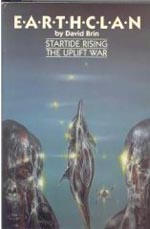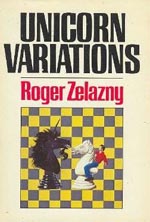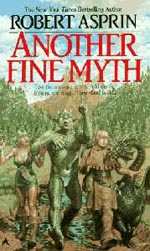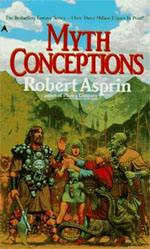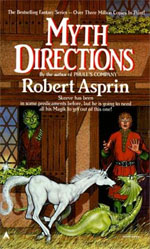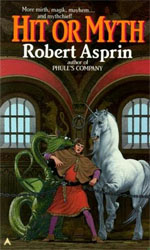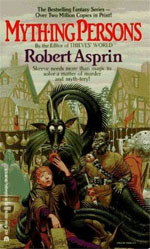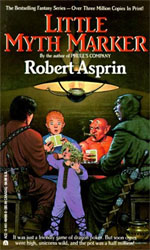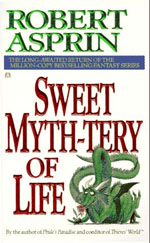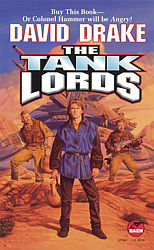Previously I’ve read Cherryh in small dollops – a single novel at a time. This isn’t because she bores me. To the contrary: I’ve found her novels to be such an intense experience that I’ve simply felt the need to take a break after finishing them. Partly to rest; partly to savor.
This time, though, I decided to punch through the chunk of Union-Alliance novels I owned but hadn’t read yet: Merchanter’s Luck, Rimrunners, Tripoint, and Finity’s End. Throwing them into my suitcase, I flew down to Mexico , and read them on the beach at the El Dorado resort while sipping Heather crème.
MERCHANTER’S LUCK
Cherryh is just plain good. There is a grandeur to a simple thing carried out with subtlety and grace. And it’s that grandeur which Cherryh achieves with Merchanter’s Luck.
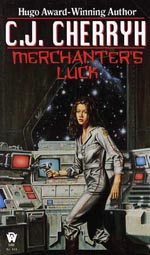 Cherryh establishes the premise of her novel from the very first sentence: “Their names were Sandor and Allison… Kreja and Reilly respectively. Reilly meant something in the offices and bars of Viking Station: it meant the merchanters of the great ship Dublin Again… Kreja meant nothing.”
Cherryh establishes the premise of her novel from the very first sentence: “Their names were Sandor and Allison… Kreja and Reilly respectively. Reilly meant something in the offices and bars of Viking Station: it meant the merchanters of the great ship Dublin Again… Kreja meant nothing.”
Merchanter’s Luck is, at its heart, a character drama – a powerful, poignant character drama. You could call it a Romeo and Juliet for the future, but it would only give you the most grotesque approximation of what this story is about. What you get to see are two characters brought together who fundamentally change each other’s lives. It’s not easy. It’s not simple. But it’s human.
Cherryh has the rare gift of being able to bare a character’s soul to the reader, and she uses that talent to great effect here: Reading Merchanter’s Luck is like watching two brightly burning stars plunging one into the other, each searing you with the heat of their existence. It’s an intense and primal reality that Cherryh shows you.
And, on that note, let’s talk about…
RIMRUNNERS
Cherryh tells you more about the character’s thought process than the character themselves are probably aware of. At first you think it’s unnatural; “No one thinks like that,” you think. But as you acclimate yourself to it, you are startled to discover a deep and profound truthfulness to the thoughts of Cherryh’s characters. Because she raises the subconscious to the conscious; and it’s a conceit, but it works.
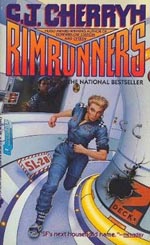 Jo Walton describes Cherryh’s Union-Alliance novels as “historical fiction”. There’s a lot of truth to that. Every novel is set across a small slice of a backdrop that stretches for decades and light years in every direction. With every novel you read in the Union-Alliance sequence, your understanding of that historical backdrop deepens and each individual work becomes ever more faceted as a result the reflections it casts upon the others.
Jo Walton describes Cherryh’s Union-Alliance novels as “historical fiction”. There’s a lot of truth to that. Every novel is set across a small slice of a backdrop that stretches for decades and light years in every direction. With every novel you read in the Union-Alliance sequence, your understanding of that historical backdrop deepens and each individual work becomes ever more faceted as a result the reflections it casts upon the others.
It’s these two factors, in combination, which make Rimrunners purr like a high-performance engine. She takes her main character, pinions her to the decaying days of a vividly invoked civil war, and then plunges into her psyche. After we’re given a chance to get a feel for what it’s like to be inside her skin, Cherryh wrenches her into a completely different situation – something roughly akin to, and with all the paranoia of, a Cold War submarine drama.
What makes Rimrunners compelling reading, from one end to the other, is the experience of living on the razor edge between death and desperation. Cherryh captures the inherent intensity of her character and then pumps it straight into your brain.
Speaking of which…
TRIPOINT
Cherryh excels at capturing utterly diverse points of view with truthfulness and integrity. Cherryh’s characters don’t see things differently because some of them are stupid or naïve or ignorant (although some of them are) – she doesn’t go in for any of those cheats. Cherryh’s character see things differently because they are fundamentally different people. And that’s pretty impressive because there just aren’t that many authors who are capable of that even at their best, yet Cherryh effortlessly accomplishes it with every novel.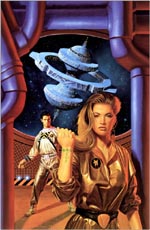
Given this unique strength of Cherryh’s, Tripoint is particularly interesting because it’s fundamentally the story of a character caught between two utterly different points of view – one embodied by his mother; the other embodied by his father – and the catalytic events which force him to find his own compromise and synthesis between those dichotomous poles.
A lot of Cherryh’s works seem to have identity as a central theme. Her characters are driven, often compulsively, by the questions of, “Who am I?” and “Who do I want to be?” Unsurprisingly, many of her stories are also tales of adolescence, and that’s the place where Tripoint exists.
Which brings us to…
FINITY’S END
… another tale of adolescence and identity. In many ways, the central character dramas of Tripoint and Finity’s End are very similar to each other. Both take a young protagonist from one environment and thrust them into another, forcing them to adapt and find a new identity for themselves.
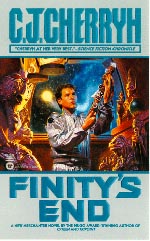 But there the similarity essentially ends. Not only are the individual characters so unlike each other as to result in completely different stories, but the plots against which their character arcs are silhouetted are fundamentally different. Tripoint is a space opera of pirates and privateers. Finity’s End is a political drama.
But there the similarity essentially ends. Not only are the individual characters so unlike each other as to result in completely different stories, but the plots against which their character arcs are silhouetted are fundamentally different. Tripoint is a space opera of pirates and privateers. Finity’s End is a political drama.
Neither novel is quite as satisfactory as it could have been. The character arc in Tripoint seems rushed and unfinished. In Finity’s End the political drama and the central character drama are not quite tightly knit enough to seem a seamless whole. (And although the lengthy discussions of taxation policy in Finity’s End were interesting to me for their pseudo-historical implications, I rather suspect that most will simply find those passages interminable.)
I will also say that, for whatever reason, midway through Finity’s End I found myself getting sick of every single Cherryh viewpoint character alternating between shaking and numbness. This isn’t fair to Finity’s End, because it just happened to be the novel where Cherryh’s authorial twitch of shaking-numbness caught up with me.
CONCLUDING THOUGHTS
As exemplary as any of these novels are on their own rights, I was particularly impressed by the strength they draw from each other. Cherryh never allows her plot to exist without impacting her characters; nor does she allow her characters to exist without affecting her setting. As a result, the more you learn of the Union-Alliance universe, the more depth each novel in the series possesses. It follows that I must, some day soon, come back to these novels (and the others in the series) and read them again. The ever-shifting, ever-growing context of Cherryh’s work gives each novel a fresh perspective and existence when viewed in each others’ light.
Somewhere in the interstice of these four novels lies an understanding of what it means to be a merchanter plying the interstellar lanes. That such an understanding is never spelled out or given a pithy summary makes it all the more meaningful and true. It is an understanding crafted by Cherryh, but wrought in your own imagination.
And that’s the true strength and legacy of these novels.
GRADES:
MERCHANTER’S LUCK: A
RIMRUNNERS: A
TRIPOINT: A
FINITY’S END: A
C.J. Cherryh
1982 / 1989 / 1995 / 1998
DAW / Warner / Aspect / Aspect
Cover Price: Out of Print
ISBNs: Out of Print
Buy Now!

